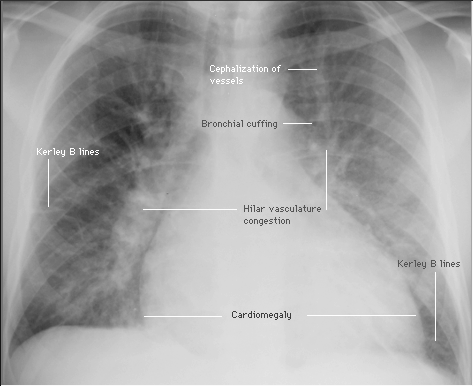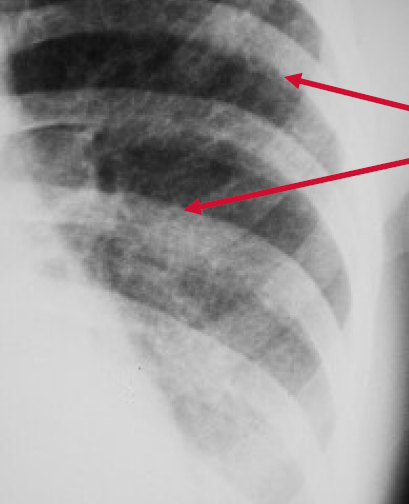Pulmonary edema chest x ray: Difference between revisions
No edit summary |
No edit summary |
||
| Line 3: | Line 3: | ||
{{CMG}} | {{CMG}} | ||
== | ==Overview== | ||
The chest x-ray is the diagnostic modality of choice | |||
[[Image:Pulmonary edema.gif|right|Pulmonary edema|250px]]The diagnosis is confirmed on [[X-ray]] of the lungs, which shows increased fluid in the alveolar walls. [[Kerley B lines]], increased vascular filling, [[pleural effusion]]s, upper lobe diversion (increased blood flow to the higher parts of the lung) may be indicative of cardiogenic pulmonary edema, while patchy alveolar infiltrates with air bronchograms are more indicative of noncardiogenic edema. | [[Image:Pulmonary edema.gif|right|Pulmonary edema|250px]]The diagnosis is confirmed on [[X-ray]] of the lungs, which shows increased fluid in the alveolar walls. [[Kerley B lines]], increased vascular filling, [[pleural effusion]]s, upper lobe diversion (increased blood flow to the higher parts of the lung) may be indicative of cardiogenic pulmonary edema, while patchy alveolar infiltrates with air bronchograms are more indicative of noncardiogenic edema. | ||
==Peribronchial Cuffing== | ==Peribronchial Cuffing== | ||
[[Image:Peribronchial cuffing.png|left|The red arrows point to thickened bronchial walls that have a doughnut-like appearance.]] Peribronchial cuffing is an abnormality on a chest x-ray whereby the usually thin bronchial walls are thickened and take on a doughnut-like appearance. | [[Image:Peribronchial cuffing.png|left|The red arrows point to thickened bronchial walls that have a doughnut-like appearance.]] [[Peribronchial cuffing]] is an abnormality on a chest x-ray whereby the usually thin bronchial walls are thickened and take on a doughnut-like appearance. | ||
==References== | ==References== | ||
Revision as of 19:06, 5 September 2011
|
Pulmonary edema Microchapters |
|
Diagnosis |
|---|
|
Treatment |
|
Case Studies |
|
Pulmonary edema chest x ray On the Web |
|
Risk calculators and risk factors for Pulmonary edema chest x ray |
Editor-In-Chief: C. Michael Gibson, M.S., M.D. [1]
Overview
The chest x-ray is the diagnostic modality of choice

The diagnosis is confirmed on X-ray of the lungs, which shows increased fluid in the alveolar walls. Kerley B lines, increased vascular filling, pleural effusions, upper lobe diversion (increased blood flow to the higher parts of the lung) may be indicative of cardiogenic pulmonary edema, while patchy alveolar infiltrates with air bronchograms are more indicative of noncardiogenic edema.
Peribronchial Cuffing

Peribronchial cuffing is an abnormality on a chest x-ray whereby the usually thin bronchial walls are thickened and take on a doughnut-like appearance.